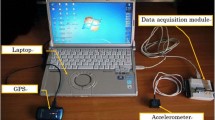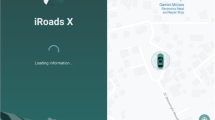Abstract
Transportation agencies spend significant resources to collect pavement roughness data using profiler vans. A potential alternative to collect functionally equivalent data at a significantly lower cost and higher level of temporal resolution is to use existing accelerometers in smartphones as the “set” of sensors. In this research, a prototype smartphone application was developed to investigate the feasibility of such an approach. Acceleration data were collected using a prototype application running on Android tablets on two routes in Virginia. The analysis results show that the proposed smartphone application can generate consistent data sets from different data collecting runs. In addition, the average of the collected data sets is found to be highly correlated with the International Roughness Index data collected by the Virginia Department of Transportation using profiler vans. Also, a sample size analysis revealed that most pavement sections require fewer than 12 data collecting trips at a 50 Hz sampling rate while fewer than 16 trips are required for a rate of 10 Hz. Finally, a preliminary benefit assessment for Virginia showed that the proposed smartphone application approach allows for collection of comparable roughness data for more roadways, more frequently with significantly less cost.
Similar content being viewed by others
References
Ahlin, K. and Granlund, N. O. J. (2002). “Relating road roughness and vehicle speeds to human body vibration and exposure limits.” The International Journal of Pavement Engineering, Vol. 3, Issue 4, pp. 207–216, DOI: 10.1080/10298430210001701.
American Association of State Highway and Transportation Officials (AASHTO) (2011). A policy on geometric design of highways and streets, 6th Edition. AASHTO. Washington, D.C.
Bridgelall, R. A. (2014). “Connected vehicle approach for pavement roughness.” Journal of Infrastructure Systems, ASCE, Vol. 20, Issue 1, DOI: 10.1061/(ASCE)IS.1943-555X.0000167.
Cantisani, G. and Loprencipe, G. (2010). “Road roughness and whole body vibration: Evaluation tools and comfort limits.” Journal of Transportation Engineering, ASCE, Vol. 136, Issue 9, pp. 818–826, DOI: 10.1061/(ASCE)TE.1943-5436.0000143.
Cochran, W. (2007). Sampling techniques (3rd Edition), Wiley India Pvt. Limited., New Delhi, India.
Dawkin, J., Bevly, D., Powell, B., and Bishop, R. (2010). Investigation of pavement maintenance applications of intellidrive SM, CTS PFS Report.
Flintsch, G. and McGhee, K. K. (2009). Quality management of pavement condition data collection, NCHRP Synthesis 401, Transportation Research Board, Washington, D.C.
Flintsch, G. W., Valeri, S., Katicha, S. W., de Leon, E. D., and Medina, A. (2012). “Probe vehicles used to measure road ride quality: Pilot demonstration.” Journal of the Transportation Research Board, No. 2304. Washington, D.C., pp. 158–165, DOI: 10.3141/2304-18.
Frankfort-Nachmias, C. and Leon-Guerrero, A. (2009). Social statistics for a diverse society (5 th Edition), Pine Forge Press, SAGE Publication, Inc., London, England.
Google (2017). Android API Guides: Motion sensors. https://developer.android.com/guide/topics/sensors/sensors_motion.html.
Mason, R., Gunst, R., and Hess, J. (1989). Statistical design and analysis of experiments: With applications to engineering and science, John Wiley and Son, Inc., New York.
Michigan Department of Transportation (2012). Connected vehicle technology industry delphi study, Lansing, Michigan.
Minnesota Department of Transportation (2007). Introduction to the international roughness index, St. Paul, Minnesota. http://www.dot.state.mn.us/materials/smoothnessdocs/IRIIntroduction.pdf.
Múčka, P. (2013). “Correlation among road unevenness indicators and vehicle vibration response.” Journal of Transportation Engineering, ASCE, Vol. 139, No. 8, pp. 771–786, DOI: 10.1061/(ASCE)TE.1943-5436.0000558.
Ong, G., Noureldin, S., and Sinha, K. C. (2010). Automated pavement condition data collection quality control, quality assurance, and reliability, Publication FHWA/IN/JTRP=2009/17. Indiana Department of Transportation and Purdue University, West Lafayette, Indiana.
Richardson, J. K., Smith, B. L., Fontaine, M. D., and Turner, S. M. (2011). “Network stratification method by travel time variation.” Journal of the Transportation Research Board, No. 2256. Washington, D.C., pp. 1–9, 10.3141/2256-01.
Robinson, R. (2012). Slippery road detection and evaluation, Transportation Research Institute at the University of Michigan.
Sauerwein, P. M. and Smith, B. L. (2011). Investigation of the implementation of a probe-vehicle based pavement roughness estimation system, Center for Transportation Studies at University of Virginia.
Sayers. M.W., Gillespie, T.D., and Paterson, W. (1986). Guidelines for conducting and calibrating road roughness measurements, World Bank Technical Paper Number 46. The World Bank, Washington, DC.
United State Department of Transportation (2012). Vehicle Based Data and Availability. Washington, DC. http://www.its.dot.gov/itspac/october2012/PDF/data_availability.pdf.
Virginia Department of Transportation (2010). State of the pavement 2010, Richmond, Virginia.
Virginia Department of Transportation (2012). Pavement management program, Richmond, Virginia. http://www.virginiadot.org/business/resources/local_assistance/Microsoft_PowerPoint_-_Local_Assistance_TC.pdf.
Author information
Authors and Affiliations
Corresponding author
Rights and permissions
About this article
Cite this article
Zeng, H., Park, H., Smith, B.L. et al. Feasibility Assessment of a Smartphone-Based Application to Estimate Road Roughness. KSCE J Civ Eng 22, 3120–3129 (2018). https://doi.org/10.1007/s12205-017-1008-9
Received:
Revised:
Accepted:
Published:
Issue Date:
DOI: https://doi.org/10.1007/s12205-017-1008-9




